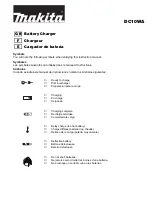
English
2
GENERAL OPERATIONAL PRECAUTIONS
1.
Keep work area clean. Cluttered areas and benches
invite accidents.
2.
Avoid dangerous environment. Don’t expose power
tools and charger to rain. Don’t use power tools
and charger in damp or wet locations. And keep
work area well lit. Never use power tools and
charger near flammable or explosive materials. Do
not use tool and charger in presence of flammable
liquids or gases.
3.
Keep children away. All visitors should be kept
safe distance from work area.
4.
Store idle tools and charger. When not in use,
tools and charger should be stored in dry, high
or locked-up place–out of reach of children. Store
tools and charger in a place where the tempera-
ture is less than 40°C.
5.
Don’t abuse cord. Never carry charger by cord or
yank it to disconnect from receptacle. Keep cord
from heat, oil and sharp edges.
6.
When the charger is not in use, or when being
maintained and inspected, disconnect its power
cord from the receptacle.
7.
To avoid danger, always use only the specified
charger.
8.
Use only genuine HITACHI replacement parts.
9.
Do not use power tools and charger for applications
other than those specified in the Handling
Instructions.
10.
To avoid personal injury, use only the accessories
or attachment recommended in these handling
instructions or in the HITACHI catalog.
11.
Let only the authorized service center do the
repairing. The Manufacturer will not be respon-
sible for any damages or injuries caused by repair
by the unauthorized persons or by mishandling
of the tool.
12.
To ensure the designed operational integrity of
power tools and charger, do not remove installed
covers or screws.
13.
Always use the charger at the voltage specified
on the nameplate.
14.
Always charge the battery before use.
15.
Never use a battery other than that specified. Do
not connect a usual dry cell, a rechargeable battery
other than that specified or a car battery to the
power tool.
16.
Do not use any transformer that has a booster.
17.
Do not charge the battery from an engine electric
generator or DC power supply.
18.
Always charge indoors. Because the charger and
battery heat slightly during charging, charge the
battery in a place not exposed to direct sunlight;
where the humidity is low and the ventilation
good.
PRECAUTIONS FOR CHARGER
1.
Always charge the battery at a temperature of 10 –
40°C. A temperature of less than 10°C will result
in over charging which is dangerous. The battery
cannot be charged at a temperature higher than
40°C. The most suitable temperature for charging
is that of 20 – 25°C.
2.
Do not use the charger continuously.
When one charging is completed, leave the charger
for about 15 minutes before the next charging of
battery.
3.
Do not charge the battery for more than 1 hour.
The battery will be fully charged in about 1 hour
and charging should be stopped when 1 hour has
elapsed from commencement. Disconnect the
charger power cord from the receptacle.
4.
Do not allow foreign matter to enter the hole for
connecting the rechargeable battery.
5.
Never disassemble the rechargeable battery and
charger.
6.
Never short-circuit the rechargeable battery. Short-
circuiting the battery will cause a great electric
current and overheat. It results in burn or damage
to the battery.
7.
Do not dispose of the battery in fire.
If the battery is burnt, it may explode.
8.
Using an exhausted battery will damage the
charger.
9.
Bring the battery to the shop from which it was
purchased as soon as the post-charging battery
life becomes too short for practical use. Do not
dispose of the exhausted battery.
10.
Do not insert object into the air ventilation slots
of the charger.
Inserting metal objects or inflammables into the
charger air ventilation slots will result in electrical
shock hazard or damaged charger.
SPECIFICATIONS
APPLICATION
For charging the HITACHI BATTERY (EB7).
CHARGER
Model
UC7SB
Charging time
Approx. 1 hour (at 20°C)
Charging voltage
7.2 V
Weight
1.0 kg
Summary of Contents for UC 7SB
Page 13: ...703 Code No C99060671 ...































